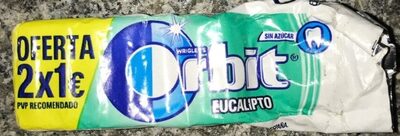Orbit - Eucalipto
This product page is not complete. You can help to complete it by editing it and adding more data from the photos we have, or by taking more photos using the app for Android or iPhone/iPad. Thank you!
×
Barra-kodea: 42247432
Markak: Orbit
Kategoriak: en:Snacks, en:Sweet snacks, en:Confectioneries, en:Chewing gum
Etiketak, ziurtagiriak, sariak: en:Contains a source of phenylalanine
Matching with your preferences
Ingurumena
Ontziratzea
Transportation
Report a problem
Datuen iturria
Product added on by kiliweb
Last edit of product page on by sebleouf.
Produktuaren orria -gatik editatua elcoco, musarana, yuka.WGIwUklxVlltdkFUdU1VRjBTclorWUpXeDVhYlhXK2NEdkF6SUE9PQ.
If the data is incomplete or incorrect, you can complete or correct it by editing this page.









